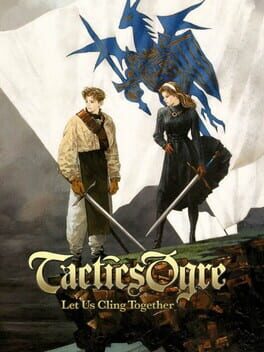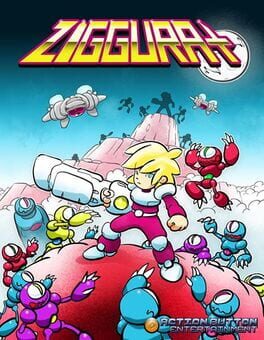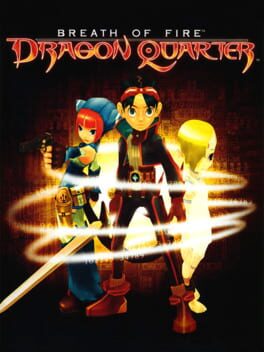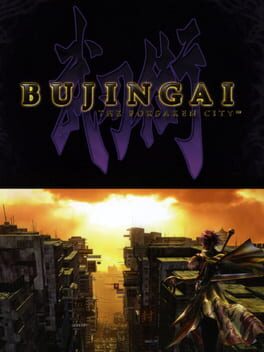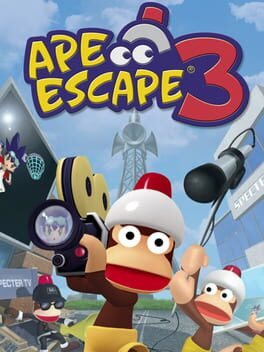Bio
Nothing here!
Badges

2 Years of Service
Being part of the Backloggd community for 2 years

Best Friends
Become mutual friends with at least 3 others

Noticed
Gained 3+ followers
Favorite Games
004
Total Games Played
000
Played in 2024
000
Games Backloggd
Recently Played See More
Recently Reviewed See More
Multi-format is a stupid term I made up for a videogame genre that I've been thinking about lately. It refers to a game where you change between different types of gameplay frequently. One of the best examples is Another World. Every few screens in Another World is a different set-piece, and what you're expected to do in each scene changes equally as often. You go from swinging over a cliff on a vine, to swinging in a cage to break it loose, to rolling through an air duct maze, and eventually to piloting an alien spaceship. None of the new mechanics are explained as they're introduced, and you perform them by using a limited set of controls that change depending on the context. Ape Escape 3 is also a multi-format game, but where a lot of Another World's gameplay consists of environmental puzzles, Ape Escape 3 has fun action.
The levels in Ape Escape 3 take place on movie sets, because the main antagonist's plan is to make such mindless television programs that humanity is lulled into a daze, and the apes can take over the world. Each level takes place in a different film genre setting where the apes mockingly reenact famous cinema, and this setup gives the game a reason to jump between new environments and set-pieces constantly, such as a Hong Kong city street or the Titanic. Every area has a huge amount of detail and variety in its set design, and it's all done with the same, clear art style.
The game's action and mechanics are just as varied. In order to catch the apes scattered throughout a level, you will need to drive a race car (with its own set of controls), drive an RC car around a miniature track, pilot a robot that controls like a Virtual-On mech, and play a top-down twin-stick shooter segment. Even in the parts of the game where you're using the standard set of items, which all control a little bit differently, the levels are made up of one-off action set-pieces, so they play as uniquely as they feel aesthetically.
The only thing that feels repetitious is the main goal of the game, which is catching the apes. Each ape is kind of like a moon in Super Mario Odyssey, but instead of being hidden behind a little puzzle or requiring you to do a specific challenge, the method for catching an ape mostly ends up feeling the same. But before you catch them, they all have their own characteristics and routines, like one that's exercising on the set of a workout video and another one that's wearing a wig in the bed from The Exorcist with its head spinning around.
The multi-format genre works for me because it has the characteristics of one of the things I like most in art, which is when something feels like it was made out of enjoyment instead of obligation to following a formula. Each segment in Another World was made chronologically after the previous scene had been designed. The person who made it didn't plan out the design of the game as a whole, he made each section based on what he thought would be cool to have happen next. In a similar way, Ape Escape 3 feels surprising because it's willing to go in any direction by changing its gameplay at any time, whereas most games won't change the fundamental actions you can perform.
Playing a multi-format game is about changing mechanics frequently, and it works best if they aren't explained and are treated as cursorily as possible, so that adjusting to the new thing will feel as surprising as possible. To that end, the controls need to be simple so they are easy enough to learn, like how everything in Ape Escape 3 is controlled with the analog sticks, and ideally the controls can be figured out through intuition.
Being able to figure out controls through intuition alone with no previous explanation I think is the highest potential for a multi-format game. The part in Another World mentioned earlier, where your character is trapped in a cage hanging on a chain from the ceiling, is an example of that. The solution is to move the direction buttons back and forth to make the cage swing far enough until the chain breaks. Nothing in the game hints at that, or even demonstrated that you could do something other than run or jump up until that point. You think you want to do something, so you try it and it happens. Most of the time in games you know what your character can fundamentally do, and the game is about working within those boundaries, so when a game is about you breaking out of those boundaries it feels emergent, as in it feels like you're acting in the game.
The levels in Ape Escape 3 take place on movie sets, because the main antagonist's plan is to make such mindless television programs that humanity is lulled into a daze, and the apes can take over the world. Each level takes place in a different film genre setting where the apes mockingly reenact famous cinema, and this setup gives the game a reason to jump between new environments and set-pieces constantly, such as a Hong Kong city street or the Titanic. Every area has a huge amount of detail and variety in its set design, and it's all done with the same, clear art style.
The game's action and mechanics are just as varied. In order to catch the apes scattered throughout a level, you will need to drive a race car (with its own set of controls), drive an RC car around a miniature track, pilot a robot that controls like a Virtual-On mech, and play a top-down twin-stick shooter segment. Even in the parts of the game where you're using the standard set of items, which all control a little bit differently, the levels are made up of one-off action set-pieces, so they play as uniquely as they feel aesthetically.
The only thing that feels repetitious is the main goal of the game, which is catching the apes. Each ape is kind of like a moon in Super Mario Odyssey, but instead of being hidden behind a little puzzle or requiring you to do a specific challenge, the method for catching an ape mostly ends up feeling the same. But before you catch them, they all have their own characteristics and routines, like one that's exercising on the set of a workout video and another one that's wearing a wig in the bed from The Exorcist with its head spinning around.
The multi-format genre works for me because it has the characteristics of one of the things I like most in art, which is when something feels like it was made out of enjoyment instead of obligation to following a formula. Each segment in Another World was made chronologically after the previous scene had been designed. The person who made it didn't plan out the design of the game as a whole, he made each section based on what he thought would be cool to have happen next. In a similar way, Ape Escape 3 feels surprising because it's willing to go in any direction by changing its gameplay at any time, whereas most games won't change the fundamental actions you can perform.
Playing a multi-format game is about changing mechanics frequently, and it works best if they aren't explained and are treated as cursorily as possible, so that adjusting to the new thing will feel as surprising as possible. To that end, the controls need to be simple so they are easy enough to learn, like how everything in Ape Escape 3 is controlled with the analog sticks, and ideally the controls can be figured out through intuition.
Being able to figure out controls through intuition alone with no previous explanation I think is the highest potential for a multi-format game. The part in Another World mentioned earlier, where your character is trapped in a cage hanging on a chain from the ceiling, is an example of that. The solution is to move the direction buttons back and forth to make the cage swing far enough until the chain breaks. Nothing in the game hints at that, or even demonstrated that you could do something other than run or jump up until that point. You think you want to do something, so you try it and it happens. Most of the time in games you know what your character can fundamentally do, and the game is about working within those boundaries, so when a game is about you breaking out of those boundaries it feels emergent, as in it feels like you're acting in the game.
An MMORPG is like a theme park designed by a government agency. In this theme park, every ride and attraction is hidden behind obscure prerequisites or busywork. I want to walk you through my experience of playing Final Fantasy XI Online, which was a somewhat early MMORPG, but this experience applies to newer MMORPGs too.
I'm sorry if this is tedious to read, but please imagine how tedious it was to live. After finishing the tutorial, I made a goal of getting to ride a chocobo, or any kind of mount. I looked up online the path to the correct town and started fighting my way across the map, leveling up along the way, returning to town to get new equipment, spells, and AI teammates. It felt about as enjoyable as a normal RPG. When reaching the man who would give me a chocobo license, he told me to go back to an area I had passed a few hours ago to find an escaped chocobo and look for its tracks. I couldn't find the tracks because they were invisible and could only be seen by using the target command in a certain area, which would have taken me a few years to figure out if I hadn't used the internet. After slowly walking back to the man, he told me to return to the town where I started the whole trip and talk to someone there. That person told me to return to the chocobo man. Finally he gave me a chocobo egg, and it turned out this wasn't the right quest to get the chocobo license, I was supposed to decline the first quest he offered me. After looking at the amount of time it would take to find the randomly dropped items that I would need to complete the correct quest, I stopped playing.
Free-to-play games make you spend money to avoid wasting your time, but MMOs make you spend money and then waste your time so you keep paying for longer. Final Fantasy XI does that more blatantly, but the other MMOs I've played do it to some degree. Which is a shame because an open-world RPG where you set your own goals is interesting to me, and Final Fantasy XI has an art style that I like more than others, even its menu design and font looked classic the first time I saw them. The problem is the goals in Final Fantasy XI all work in reverse. Every town has so many things you can do, there's a tailor shop where you can buy twenty different kinds of cloth, a store that sells carpentry materials, every creature you kill can leave behind an item that goes unexplained, and most characters you talk to serve some function. There are a bunch of threads lying around all over the place, but no one tells you which ones to pick up or if they'll lead anywhere you're interested in. Instead of telling you the end goal and then letting you know how to get there, you find a store that sells an absolute plethora of wood but they don't explain how to use it or why you would care if they did.
Final Fantasy XI is like a theme park designed by a government agency because like a theme park, you're in a simulation of an adventure, but still a tourist contained in a sterile place where you have no effect. And like a government agency it makes you feel not like a small cog in a big wheel, but insignificant in how little it's designed to accommodate you, and despised in how it values you and your time.
I'm sorry if this is tedious to read, but please imagine how tedious it was to live. After finishing the tutorial, I made a goal of getting to ride a chocobo, or any kind of mount. I looked up online the path to the correct town and started fighting my way across the map, leveling up along the way, returning to town to get new equipment, spells, and AI teammates. It felt about as enjoyable as a normal RPG. When reaching the man who would give me a chocobo license, he told me to go back to an area I had passed a few hours ago to find an escaped chocobo and look for its tracks. I couldn't find the tracks because they were invisible and could only be seen by using the target command in a certain area, which would have taken me a few years to figure out if I hadn't used the internet. After slowly walking back to the man, he told me to return to the town where I started the whole trip and talk to someone there. That person told me to return to the chocobo man. Finally he gave me a chocobo egg, and it turned out this wasn't the right quest to get the chocobo license, I was supposed to decline the first quest he offered me. After looking at the amount of time it would take to find the randomly dropped items that I would need to complete the correct quest, I stopped playing.
Free-to-play games make you spend money to avoid wasting your time, but MMOs make you spend money and then waste your time so you keep paying for longer. Final Fantasy XI does that more blatantly, but the other MMOs I've played do it to some degree. Which is a shame because an open-world RPG where you set your own goals is interesting to me, and Final Fantasy XI has an art style that I like more than others, even its menu design and font looked classic the first time I saw them. The problem is the goals in Final Fantasy XI all work in reverse. Every town has so many things you can do, there's a tailor shop where you can buy twenty different kinds of cloth, a store that sells carpentry materials, every creature you kill can leave behind an item that goes unexplained, and most characters you talk to serve some function. There are a bunch of threads lying around all over the place, but no one tells you which ones to pick up or if they'll lead anywhere you're interested in. Instead of telling you the end goal and then letting you know how to get there, you find a store that sells an absolute plethora of wood but they don't explain how to use it or why you would care if they did.
Final Fantasy XI is like a theme park designed by a government agency because like a theme park, you're in a simulation of an adventure, but still a tourist contained in a sterile place where you have no effect. And like a government agency it makes you feel not like a small cog in a big wheel, but insignificant in how little it's designed to accommodate you, and despised in how it values you and your time.
Bujingai begins with a cold open. When you first start the game, it shows the development studios, then the camera moves to your character and you're able to begin playing through the first level. After a few minutes, the screen fades out and the opening credits start, with a video replay of what you just did during the level cut between scenes. It's one of a few instances where the game tries to make playing it look cool, that and the main character is modeled after Gackt.
The opening turns the actual gameplay into a cinematic, and there are a few other cinematic moments. When you counter-attack an enemy, it locks you into a duel, and as yours and the enemy's swords are interlacing, the camera shifts around the fight at different angles while you go back and forth between attacking and defending. Even though this takes away your control of movement and the camera, you're still controlling the action just by timing when you press the attack button. Also, sometimes when you start a duel both you and the enemy will spin into the air and jump away from each other, landing in a pose that you both keep for a few seconds. I don't know why this happens, but the game making the characters break apart to do a superfluous pose in the middle of a fight feels cinematic.
The movement is the most impressive thing in the game. You can run up walls and fly for a little bit as part of your jump. When you're in an enclosed space you can jump off a wall to flip behind an enemy and it actually looks as cool as it feels. Just running around an empty level was some of the most fun I had in the game, because I don't think the people who made it really knew what to do with the movement in their level design. There's no limit to how long you can run up a wall, and you could probably jump and fly around any level design or enemies they wanted you to engage with, so they made invisible barriers around the levels and mandatory numbers of enemies you have to kill in order to unlock doors so you can keep going. Once you fight an enemy, you usually aren't able to use your movement in an interesting way, so you just attack until they fall down, and wait for them to stand back up like in any beat-them-up game.
Bujingai does have kind of a simplified attack control scheme compared to other 3D action games. You just press the attack button until you decide to start a combo of which there are only three choices, each with its own use. I actually like this more than games where you learn a bunch of button-press combinations to do unique moves. It seems like it puts more emphasis on where you are physically in relation to the enemies around you, so crowd-control and movement become more important. I think it's the same reason why Super Smash Bros. appeals to some people who don't care about other 2D fighting games. Bujingai doesn't really live up to that, but if there was a game where you had as much freedom of movement as you do here, and you could use it to pull off situational-based combos depending on where you're located in relation to the enemies physically, as well as having cinematic elements mixed in with every fight, it would probably be my favorite action game.
The opening turns the actual gameplay into a cinematic, and there are a few other cinematic moments. When you counter-attack an enemy, it locks you into a duel, and as yours and the enemy's swords are interlacing, the camera shifts around the fight at different angles while you go back and forth between attacking and defending. Even though this takes away your control of movement and the camera, you're still controlling the action just by timing when you press the attack button. Also, sometimes when you start a duel both you and the enemy will spin into the air and jump away from each other, landing in a pose that you both keep for a few seconds. I don't know why this happens, but the game making the characters break apart to do a superfluous pose in the middle of a fight feels cinematic.
The movement is the most impressive thing in the game. You can run up walls and fly for a little bit as part of your jump. When you're in an enclosed space you can jump off a wall to flip behind an enemy and it actually looks as cool as it feels. Just running around an empty level was some of the most fun I had in the game, because I don't think the people who made it really knew what to do with the movement in their level design. There's no limit to how long you can run up a wall, and you could probably jump and fly around any level design or enemies they wanted you to engage with, so they made invisible barriers around the levels and mandatory numbers of enemies you have to kill in order to unlock doors so you can keep going. Once you fight an enemy, you usually aren't able to use your movement in an interesting way, so you just attack until they fall down, and wait for them to stand back up like in any beat-them-up game.
Bujingai does have kind of a simplified attack control scheme compared to other 3D action games. You just press the attack button until you decide to start a combo of which there are only three choices, each with its own use. I actually like this more than games where you learn a bunch of button-press combinations to do unique moves. It seems like it puts more emphasis on where you are physically in relation to the enemies around you, so crowd-control and movement become more important. I think it's the same reason why Super Smash Bros. appeals to some people who don't care about other 2D fighting games. Bujingai doesn't really live up to that, but if there was a game where you had as much freedom of movement as you do here, and you could use it to pull off situational-based combos depending on where you're located in relation to the enemies physically, as well as having cinematic elements mixed in with every fight, it would probably be my favorite action game.
